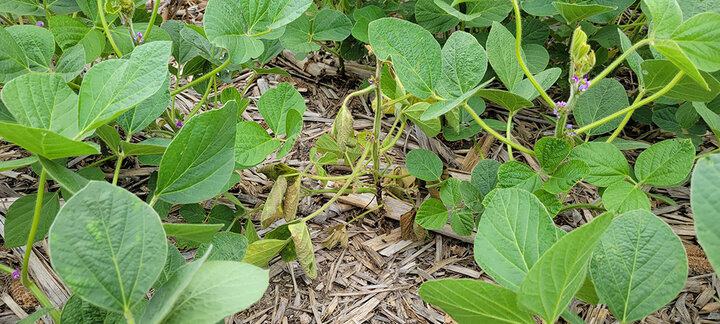Regions around the state have faced different planting conditions, and unfortunately there is a soybean seedling disease for all of them. We typically expect to see more seedling disease in soybeans during cool wet springs; however, these conditions mostly favor the fungal-like organisms called water molds. You may have heard these called by their names: Pythium and Phytophthora. While these are present out in the state, there are also drier fields that are seeing pressure from the fungal pathogens Fusarium and Rhizoctonia. These latter two are more common in sandy or well-drained loamy soils.
The symptoms caused by all four of these pathogens often share similar features and are characterized by seedling damping off. This is where moisture is unable to translocate through diseased root and vasculature tissue and the plant dries down. This can happen after emergence and you will find the dried seedling in its row, or it can happen before emergence and you will only see gaps in your planted rows (Figure 1). In the latter situation, digging for the rotted seedling could shed some light on the situation. In most cases, plant disease management is disease specific. For this reason, it is important to determine which seedling disease you are dealing with.

Pythium
Wet conditions are favorable for Pythium, which is our most common seedling disease of soybean in Nebraska. Cooler soil temperatures will make this worse as the seedling will be stressed and grow more slowly.
Typical symptoms of Pythium will include seed decay, pre-emergent seedling rot, and seedling damping off after emergence. If the plant has emerged, it will often have a root system where the outer layer can be easily pulled off and the center of the root will stay intact.
Rhizoctonia Root Rot
Rhizoctonia is favored by drier conditions and will occur more commonly in sandy or well-drained loamy soil types. Rhizoctonia will be evident as reddish-brown lesions on the lower stem (typically at the soil level).
Fusarium Root Rot
Fusarium is commonly favored by dryer conditions and in sandy or well-drained loamy soil types. Infected soybean crops will have stunted plants with brown to black discoloration on the roots (often in the lower portion of the root system).
Phytophthora
As soil conditions warm up, Phytophthora often will become more common with heavy rains. Fields will typically have a history of this disease, which will flare up when rain events saturate soil profiles. Phytophthora is often culpable when a field was planted with a standard rate of seed treatment but still has significant stand reduction when wet conditions occur. This will be a field-specific issue and usually does not occur as often as Pythium.
Typical symptoms of Phytophthora are seed decay and pre-emergence seedling rot, and seedling damping off after emergence. Typical symptoms on seedlings are darkened stems at the base of the plant coming up from the soil line (Figure 2). When young plants are cut at the lower stem, often there will be a dark center to the stem. Phytophthora can kill plants at any stage of development, but Pythium typically does not kill plants much past the V5 growth stage.

Management
Management of seedling diseases can be achieved by improving field conditions for seedlings. Improving drainage of low-lying wet areas can help reduce the incidence and severity of some seedling diseases. Another option is delaying planting until more favorable conditions exist for rapid germination and emergence. However, delaying planting too long can negatively impact yield potential.
The most common method for disease management is the use of seed treatment fungicides. These products can provide protection against some of the pathogens that cause seedling diseases; however, most only provide protection during the first few weeks immediately after planting. Despite their activity, diseases may still develop, such as during extended periods of inclement weather or under severe pathogen pressure. Often greater seed treatment options are available for soybeans as they are not all pre-treated. This allows more specific targeting of the pathogen and emphasizes why a proper diagnosis is important.
Some fungicides now also are labeled for application at planting, in or near the seed furrow. Use of fungicides at planting may provide some additional protection against these and other pathogens, there is currently ongoing research to better understand their potential benefits, interactions and potential economic return.
You can minimize the likelihood of developing seedling diseases by planting high quality seed at appropriate planting depths and soil conditions to support rapid plant growth and emergence.
For more information, please visit the CropWatch Soybean Disease Management page.
